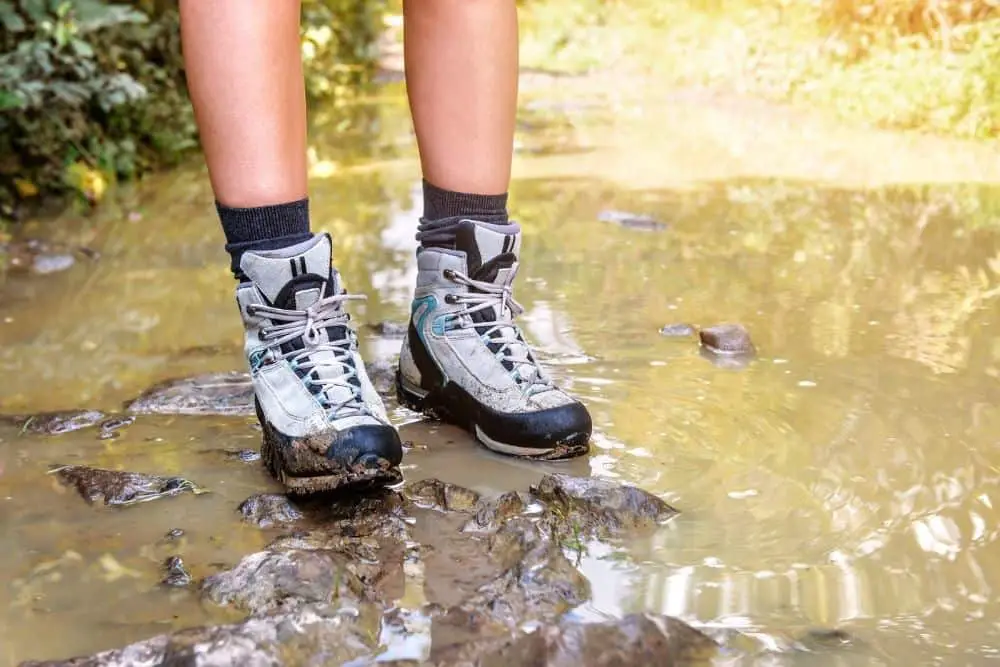If you hike regularly, you should know that some trails require extra carefulness when hiking through them. And one of those terrains is the muddy terrain.
It almost doesn’t matter if you are going on a long or short hike; you have to pay attention to what you do so you don’t hurt yourself.
Usually, muddy terrains tend to be slippery, and you know how it feels when you walk on such grounds. A lot could happen in muddy terrain; for instance, falling, slipping, dirt on your feet, and maybe worse, twisting your ankle.
Since hiking in muddy trails is fragile, it makes you wonder what appropriate footwear to wear on the trail. This is why there have been questions as to whether you can wear hiking boots in the mud.
Yeah, we know hiking boots are fantastic with all of their features, and they are most suitable for hiking. But are they good for mud?
In this article, you’d discover whether hiking boots are suitable for mud. Plus, you will get to know the features that make them suitable or unsuitable for muddy terrains.
Let’s get started!
Contents
Are Hiking Boots Good For Mud?
The simple answer to that is yes. Of course, hiking boots are good for mud; why? These boots have all the necessary features you need to feel comfortable and protected on the trail.
Plus, the manufacturers know that hiking trails are unpredictable, and going on hikes can be entirely different from regular activities. So, what makes hiking boots suitable or unsuitable for mud?
Pro Features of Hiking Boots Making Them Good For Mud
As earlier stated, you can wear hiking boots in the mud, as they ensure that you are safe and comfortable on the trail to an extent. And this is possible due to certain hiking boots’ features. So, what are they?
1. Waterproof membrane
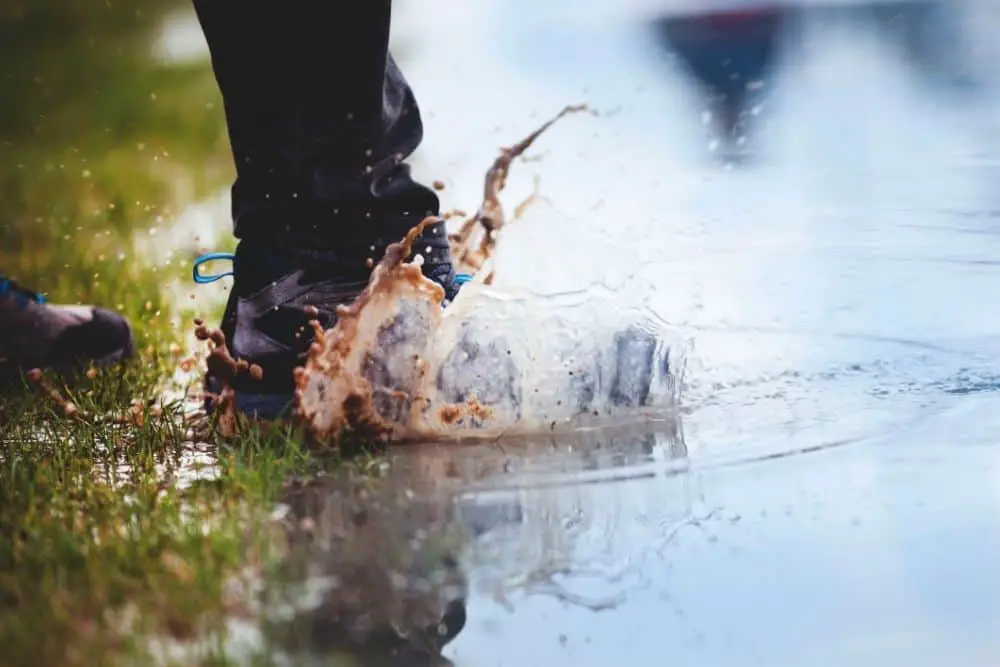
One prominent feature of hiking boots that makes them good for mud is their waterproof features. Usually, most hiking boots are waterproof, and manufacturers make them that way so that your feet don’t get wet on the trail.
As you know, muddy terrains are usually water-logged or have a presence of high water levels. Now, when this wetness gets to your feet, it can cause irritation and discomfort to you on the trail.
Simply know that if you are hiking on this type of trail, it means your socks and feet are susceptible to getting wet. Therefore, you need footwear that would ensure that you keep dry feet on the trail.
The feature of hiking boots that will prevent the wetness from getting to your feet is the waterproof membrane. Now, this membrane lines the entire upper part of the boot, completely securing water out.
Besides, you can add waterproof spray on them to retain or boost their function by spraying the upper material to aid the membrane. This feature alone makes them suitable for a partially wet landscape like muddy hiking terrain.
2. Non-slip outsoles
The rubber outsole that comes with grippy tread patterns and somehow deep lugs is part of the hiking boots making direct contact with mud.
You must have heard a lot about traction when hiking is concerned. Now, these outsoles, as the name suggests, “non-slip”, help you to maintain your stance on hiking terrains, so you don’t fall or slip.
Once you can maintain your stance, it enables you to stay balanced on the trail. So, you can hike uphill and downhill with reduced risks.
Typically, mud is slippery, and walking on it barefooted or using footwear without lug patterns can make you fall on your face. This is why we suggest to anyone to wear footwear with non-slip outsoles; for instance, hiking boots.
3. High-cut or mid-cut design

Another reason why hiking boots are good for mud is their ankle support features. Hikers and experts cannot stress this fact enough that ankle support is essential when hiking, especially in mud.
A proper supply of this feature ensures that your ankle remains stable to hold up your body weight on the trail. When you don’t get enough ankle support, the pressure may distribute to other parts of your body, causing it to ache after the hike.
Also, you don’t want to put yourself at risk of a twisted ankle. Before we get too deep into that, what part of hiking boots provides the ankle support you need in muddy terrains?
None other than the high-cut or mid-cut designs of hiking boots. However, these designs don’t provide ankle support alone. They usually have padding lining their interior surfaces to keep the ankles cushioned and stiff.
Additionally, some hiking boots experts might suggest the stiffness of the upper add to the ankle support provided by the high-cut or mid-cut designs. However, hiking boots design primarily come in three heights; mid-cut, low-cut, or high-cut, depicting how high the upper top is.
So, the higher the top is, the more ankle support you get.
4. Gusseted tongues
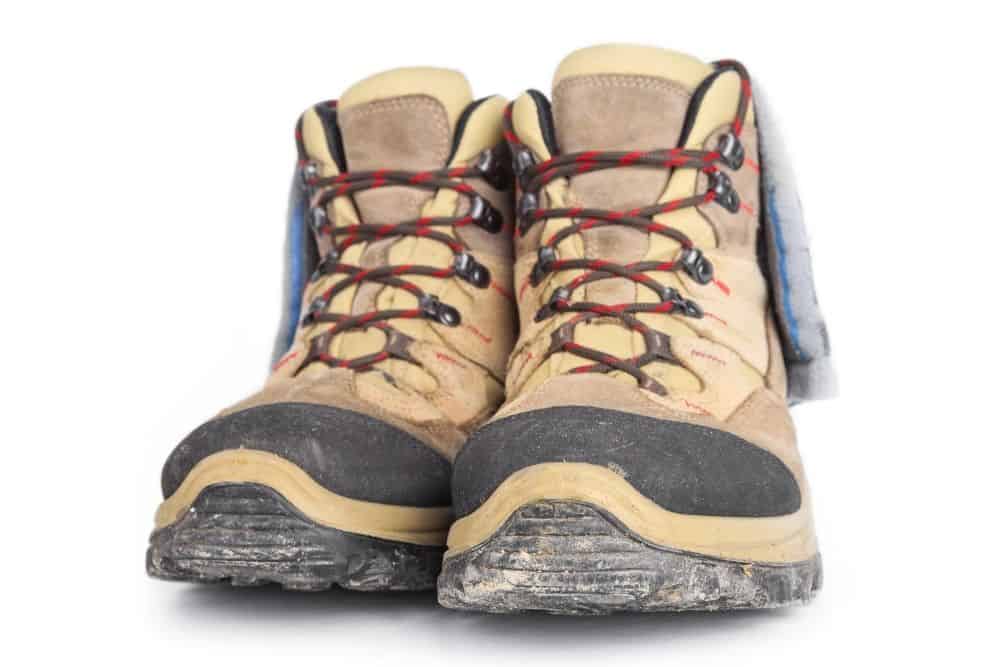
Here’s the deal with this feature; it serves the purpose of helping to keep wet sand (or mud) particles from entering the boot. Usually, when hiking in the mud, there are increased chances of mud particles entering your boot; however, they are prevented.
The gusseted tongues of hiking boots usually lie beneath the laces. And they pretty much act as a guard against dirt, mud, debris, or any tiny particles. If this feature is absent, you will discover that your hiking boot will house mud particles on its inside, which can be harmful to your foot health.
5. Midsole and insole
For any hiking trip, you will ever embark on, one function must never be lacking, and that’s comfort. When hiking on terrain that is muddy, you will notice that it feels soft upon each step, but hard to come out of due to its high viscosity and stickiness.
Well, all these strains, especially when making each step, the cushioning midsole and insole tend to add extra comfort for your feet. This way, you can be sure of a less stressful hike, with little to no foot pain.
Last update on 2023-11-10 / Affiliate links / Images from Amazon Product Advertising API
Hiking Boots Features That Make Them Unsuitable For Mud
While hiking boots are good for hikes in the mud, there are still some features that make their use in muddy terrains questionable. So, what are these features?
1. The deep lugs and grooves

We mentioned before that the non-slip outsoles make hiking in mud safe and good. But, now we seem to talk negatively about a feature that’s part of the non-slip outsole of hiking boots. Why the contrast?
The patterns beneath the outsole that help ensure traction and stability can also be a problem. How?
The more you hike on this terrain, the faster you are going to collect mud in between the lugs underneath your hiking boot. First, this reduces their grip on the mud and may make them susceptible to slipping on the trail.
So, you may need to go with trekking poles to serve as support when that happens and balance it up. Another thing is that when the mud dries up, it can be hard to get out of the hiking boots.
Therefore, cleaning under the hiking boots makes it somewhat stressful. In addition, you’d discover that hiking with mud stuck between the grooves and lugs in the outsole makes the footwear heavier than usual.
2. It’s not easy to clean
Most hiking boots are made from leather variations, fabrics or synthetics that are not easy to clean when sticking with mud. So, getting the mud off your hiking boots can be complicated.
It could be worse if the mud dries up on your boots. This can somewhat be unavoidable since you have to wear the hiking boots back home, and of course, the last thing on your mind would be to clean your boots immediately.
However, it may be hard to clean thoroughly when the mud dries up under the lug, sole, material, or other parts of the hiking boot. However, you don’t need to worry because there are some methods to clean hiking boots that you can try to get mud completely off.
3. Vented holes and eyelets
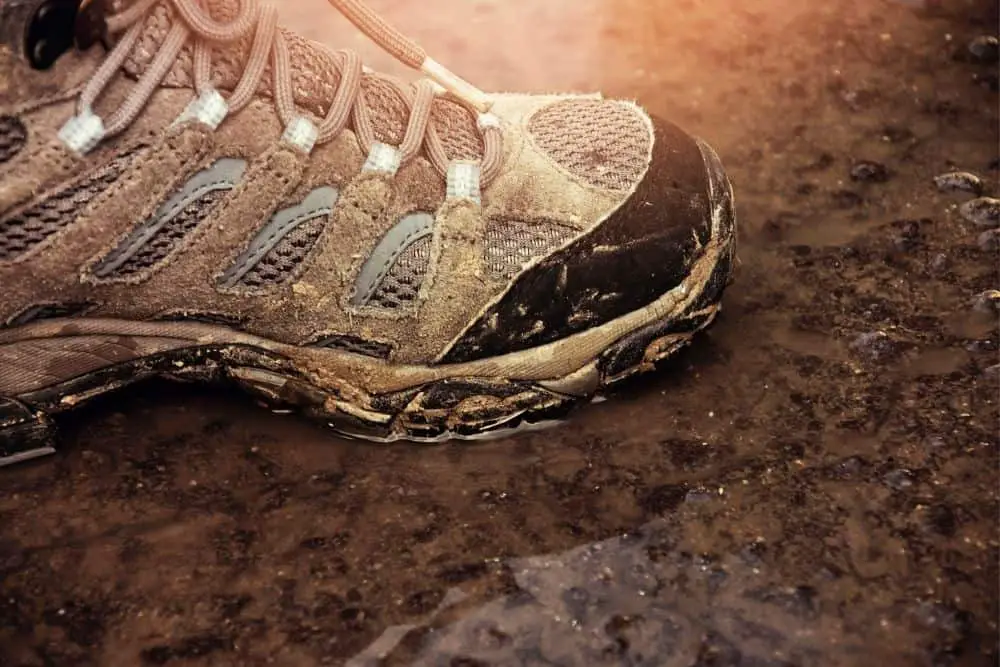
Typically, manufacturers of hiking boots plan this feature to be a helpful one. But, along the line, they tend to be the enemy when hiking in muddy terrains.
The eyelets and holes usually are there to allow proper circulation of air in and out of the hiking boot. However, they can become passage routes for mud to get in and out of the boot. And as we have stated earlier, mud getting into your hiking boot while on a hike can be bad for your feet.
4. Deteriorate leather
Another reason why hiking boots are unfit for walking in mud is because of their uppers. First, you should know that sand can ruin your hiking boots, especially when the material is leather.
If mud sticks to your hiking boots and dries on them by chance, it would be hard to get out. And if you are lucky to clean them, there may be sand residuals left in the boots.
This could make the leather dry out and sap the shine in your hiking boots. However, this is not to say that you cannot clean your hiking boots if mud dries on them.
But then, it could put your hiking boots at risk of cracking since they don’t have the oil that makes them shine in them. The good thing is there is a solution to that. You can continuously condition, wax, or polish your leather hiking boots to return their shine and prevent them from cracking.
5. Weight
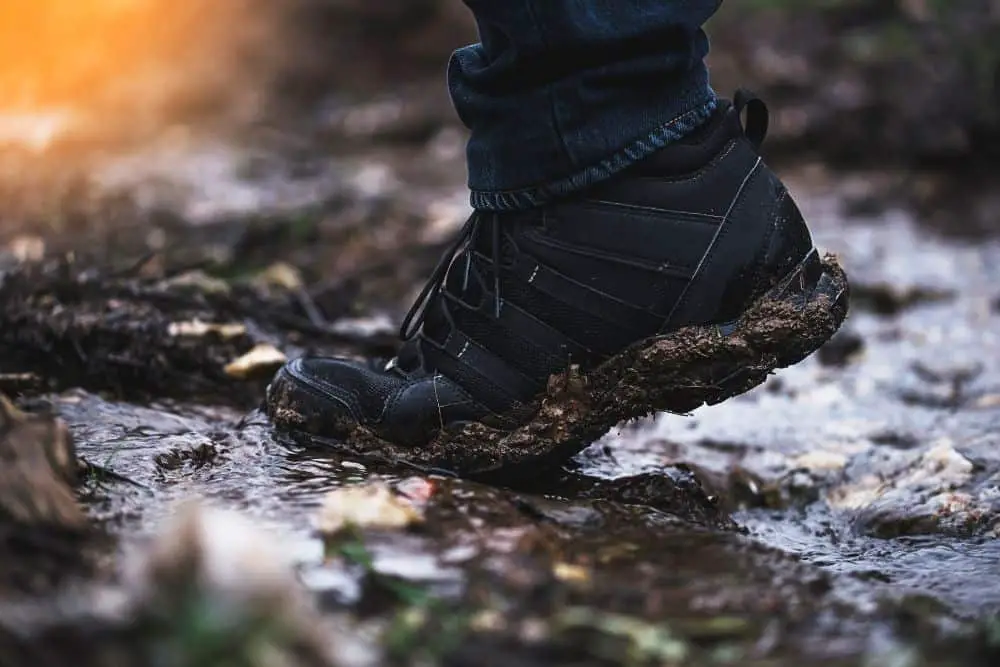
Of course, hiking boots are suitable for hiking in the mud, but that could suddenly become a bad choice when they become heavy on the trail. You know how well mud can accumulate under your footwear after walking on them for a while.
The bad news is that, once they stick, they hardly get off unless you make efforts to remove them from your boots. After hiking in the mud, there’s every chance of mud sticking to the surrounding, especially the outsole of the boot.
The effect of this unavoidable incident will likely cause an increase in the overall weight of the hiking boot. So, imagine wearing a 4lbs hiking boot in the mud that could quickly pick up more pounds to the weight on your feet.
Lifting such hiking boots will become pretty stressful, and can be more tedious. So, you may want to reconsider wearing heavy hiking boots on the trail.
How To Choose Hiking Boots Good For Mud?
Choosing the proper hiking boots for walking in muddy terrain is crucial. Why?
You need to be sure that they will protect you completely and make you comfortable on the trail. So, what are the things you should look out for when selecting hiking boots good for mud?
1. Proper fit
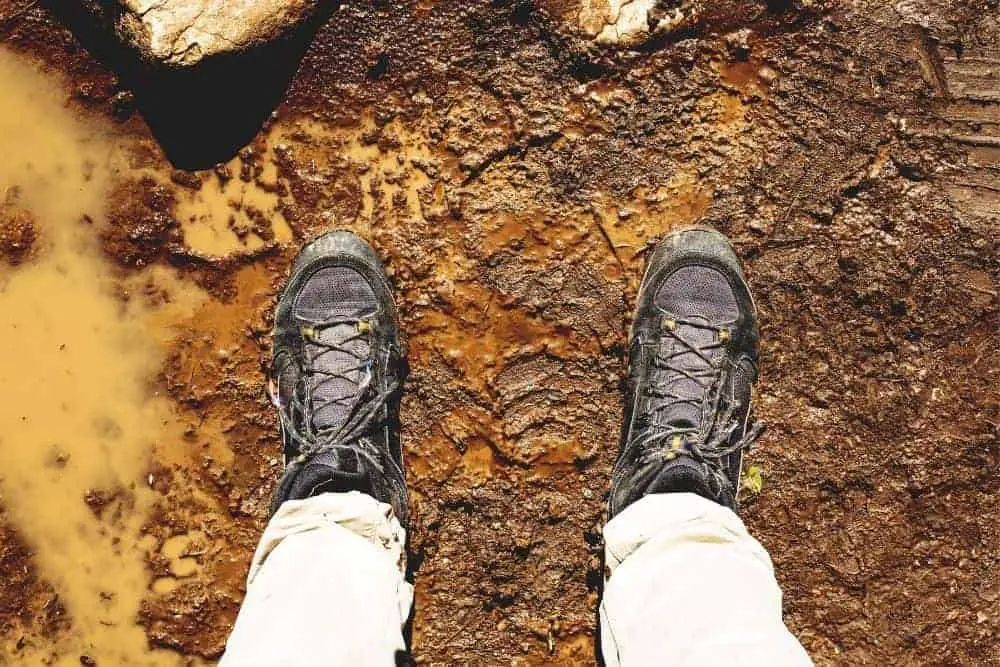
First and most importantly, you need to pick the rightly sized hiking boot fit for you. This doesn’t only apply to walking in the mud alone but all hiking terrains. If your hiking boots are too loose or tight, you have indirectly signed up for discomfort on the hiking trail.
It’s either you squash your toes against each other or be ready to walk sloppily on the trail or heel slippage. So, wear hiking boots that fit appropriately and snugly around your feet.
2. Upper materials
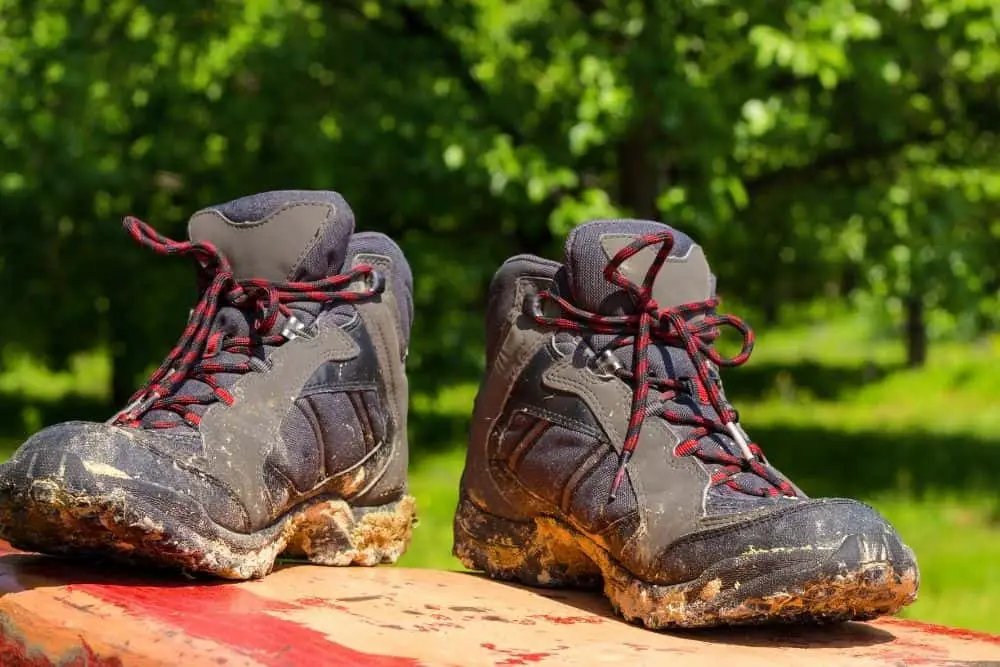
When choosing hiking boots for mud, you need to choose tough and waterproof materials. As earlier stated, hiking boots’ materials also contribute to the overall waterproofness of the footwear.
For example, leather hiking boots are more waterproof than other materials and can protect your feet from getting wet. But, they lack the anti-abrasive feature, which makes them vulnerable to this terrain.
Plus, allowing your leather hiking boots to soak in the mud will likely deteriorate their quality, especially faux. For this reason, you might want to change your gaze to other materials like synthetics (Denier or Cordura Nylon).
We won’t advise that you go for mesh because it will damage quickly on this type of trail. And as for the synthetics they possess anti-abrasive and easy-to-clean effects, making them less vulnerable.
3. Lightweight
When selecting hiking boots for mud, you should go for lightweight hiking boots. You don’t need that much weight to walk in the mud. Why? They would slow you down and sour your experience on the trail.
Plus, your hiking boots would probably get heavier from walking in the mud after a while, so you sure want to cut on the weight. So, we would advise that the ideal weight you should go for your new hiking boots for muddy trails be 2lbs and below.
4. High-cut design

You should also go for hiking boots with a high-cut design. First, they would provide you with enough ankle support to walk on the slippery terrain.
Second, they would prevent mud, dirt, or other particles from getting into your hiking boot. That way, you can prevent dirt from getting in and gain some ankle support at the same time.
5. Thick lugs
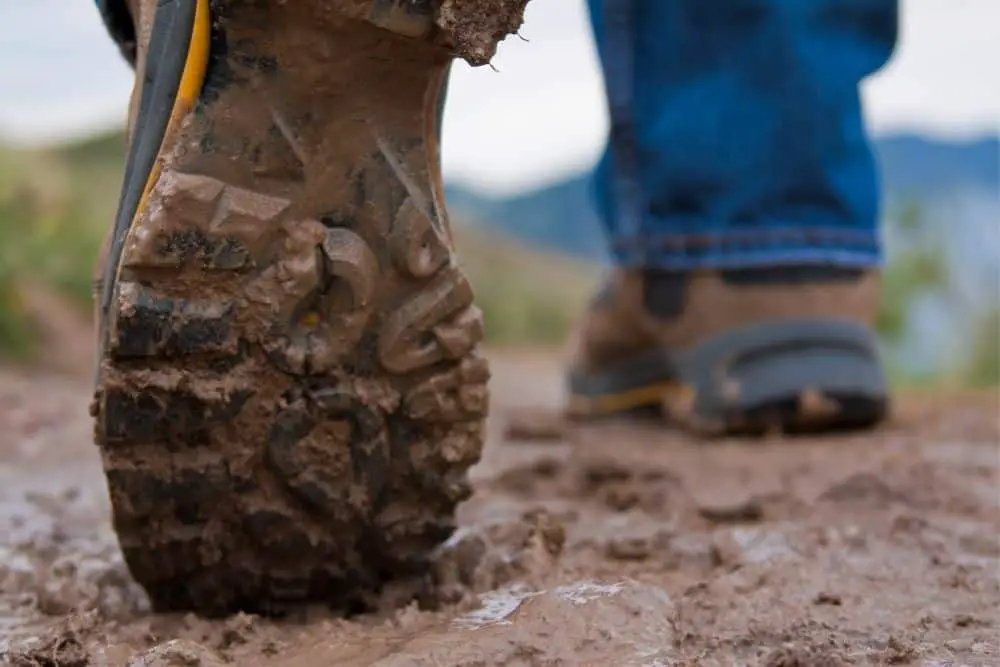
Another thing to notice when selecting hiking boots for mud is their lugs. You should be sure that the lugs are nicely patterned enough to grip the terrain and make you stable on the trail.
However, you will want to be mindful of the kind of patterned thick lugs you pick. You don’t want mud getting stuck all around the outsole of your hiking boots, which can be utterly discomforting.
6. Raised soles or heels
You should also pick hiking boots with raised soles and heels. Preferably, we would advise that you go for hiking boots having 1.5″ heels.
This will help elevate your feet on the trail so water doesn’t get a chance to enter your hiking boots. Also, it helps keep the mud down below rather than make them shift to the upper part of your hiking boots.
7. Rubber rands

This feature is not quite popular in most hiking boots but since you are about to be exposed to wet and muddy conditions on your upcoming hike, I highly recommend picking hiking boots with rubber rands.
Rubber rands are often included in some rugged hikes that may require more protection for your feet and toes to prevent injuries on the go.
This rand is technically a rubber layer that is placed right above the outsole.
They can be designed to either wrap around the bottom upper area where the sole and upper part of the hiking boots meet, or just cover the top of the boot.
This may add up a couple of weight on your feet but since rubber is pretty waterproof, it lessens your efforts to wash and clean the upper from dirty mud at the end of the hike.
Conclusion
Getting the proper footwear for different trails is essential for your safety and convenience on the terrain. And since hiking in the mud means the terrain is soft, you should be extra careful, so you don’t end up with an injury.
For this reason, hikers would want to know if hiking boots are good for mud. And the answer to that is yes; hiking boots are good for mud. However, some people would disagree, but you can always educate them with the knowledge gained from this article.
So, since you have all the information you need to select the right hiking boots for mud, we wish you safety on the trail. Happy hiking!

